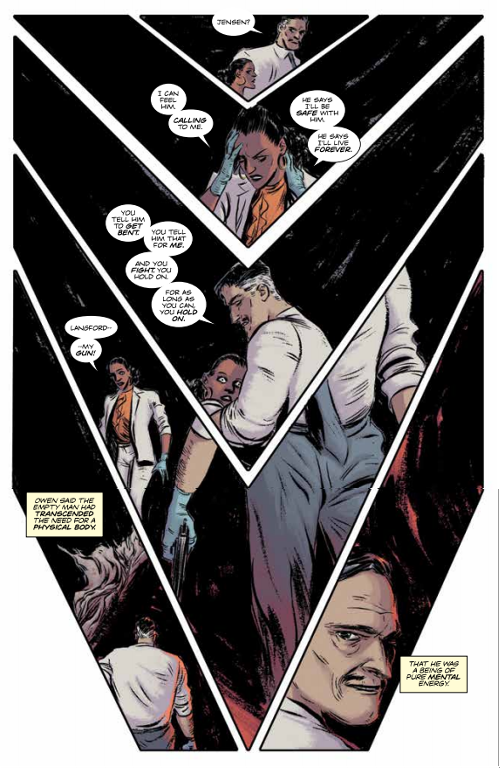The Empty Man is a six-issue series written by Cullen Bunn with art by Vanesa R. Del Rey that explores an incredibly interesting, if hard to nail down, concept: a thoughtform virus (or deity) is invading our world from the plane of thought, causing terrifying hallucinations and self-destructive violence, as victims frantically whisper, scrawl or scratch variations on “The Empty Man made me do it.” Cults and investigatory taskforces have sprung up around the disease. Our entry point is with two agents from a joint CDC-FBI taskforce, Walter Langford and Monica Jensen.
If that sounds like a lot to take in, that’s because it is. So much background is necessary to set the stage for this climactic conflict in “solving” the Empty Man that a six-issue series is just too small to contain it. We aren’t even introduced to our two protagonists until halfway through the first issue, because before we can understand what they’re doing, we have to know what they’re up against. That is not to say this late introduction is unforgivable—The Empty Man seems more concerned with its conceit than its characters throughout, and the conceit is worth the attention—but it does contribute to this feel of a sprawling epic that ends up feeling not only rushed but also frustratingly incomplete.

An Empty Man victim appears to be tearing at his ear, attempting to claw the voices out of his head.
Del Rey’s rough-hewn style, in the mode of Rafael Albuquerque, at points lacks the clarity of the Brazilian artist’s panels, rendering some action sequences hard to track. Del Rey’s murky style is indicative of both the strengths and weaknesses of the book as a whole: its thick, smudged lines lend a sense of looming uncertainty, inviting readers to stare long and hard, searching for the next threat and trying to fully understand the evidence presented to them. That is not to say Del Rey’s panels are indecipherable, but some details are lost, costing some seriously strong horror moments, such as the revelation of a North Carolina warehouse full of extremist “Witnesses,” a cult so obsessed with seeing, hearing, and speaking what the infected have experienced, they kidnap Empty Man victims en masse, removing their eyes, ears, and tongues and pressing them to their own. (However, it is worth noting that the scorpion-Venom-horror that is the Empty Man’s physical embodiment works excellently within Del Rey’s style.)
As a result, The Empty Man’s mysteries are rendered perhaps more impenetrable than Cullen Bunn and Del Rey intended. Multiple theories and interpretations are suggested throughout the book, but, while each is interesting, they coat the core narrative—Langford and Jensen’s search for a pair of children missing from an Empty Man crime scene that claimed both their parents—in a murky haze that, instead of invoking the dread of uncertainty, serves as a buffer between the reader and the horrors the agents encounter. Conflicting theories, instead of arising from new developments in the case, exist from a time before we join the narrative, so they crowd out potential new revelations and understanding, causing the plot, already pressed for time, to meander down dead-end turns, touring the labyrinthine world of the Empty Man before arriving at a quite brilliant conclusion in the sixth and final issue.
Although that truth becomes clear in the sixth issue, that issue itself feels like a fantastic second- or third-to-last release. We are left with Langford and Jensen finally understanding the Empty Man and what they have to do. Their plans are risky, but they’ve chosen to act on them. And then the book ends. Will they save the world? Will they die trying? Will their (until about an issue ago absolutely implausible) plans even be doable? We just don’t know, and it doesn’t feel like a productive, meaningful ambiguity. I understand that this book is about the mystery itself and its unraveling, not some sort of FBI-CDC sword-and-sorcery (gun-and-antihistamine?) quest, but it feels like a copout to take us right up to the precipice of the annihilation of consciousness as we know it and then…not tell us if it happens. Up until that last page, I was wholly willing to recommend this series, but now, I worry you’ll feel your time reading was wasted. I don’t feel that way, but I can see where a reader with that stance would be coming from. Now I’d give this more of a “read and enter…if you dare” stamp. The information payoff is pretty fantastic, even if the plot payoff doesn’t really happen. It almost seems like the setup for a sequel, but no such book has been announced.

Just one example of the many ways The Empty Man uses triangular panels as the disease’s threat level reaches its apex.
It may sound like I find Del Rey and Bunn’s storytelling chops suspect, but that’s not the case. There is an excellent triangle motif woven throughout the series. It appears often in panel layouts and alludes to symbols often associated with the Empty Man, and the triangle shapes become more and more prevalent as the threat of the Empty Man comes closer and closer to its endgame, expressing the scope and strangeness of the danger in an innovative way that was downright masterful. Still, this book feels like a ten- or twenty-pound idea in a five-pound bag. This could have been an excellent eight-, ten-, or twelve-issue series, but, as it stands, readers are left with four confusing but interesting issues; two excellent, mind-bending ones; and zero firm knowledge of how the plot resolves. The highs of the final two issues make the abrupt ending all the more difficult to stomach, leaving one to hope for a sequel, expanded edition, or at least an explanation.


